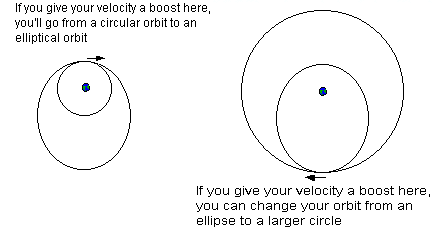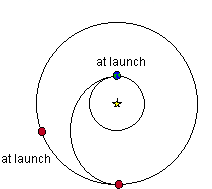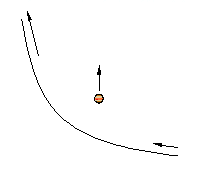

1. Historical overview
2. How to get to space: propulsion systems
3. How to travel in space, once there: orbital mechanics
4. Machines in space: satellites and space probes
5. People in space
HISTORY OF SPACEFLIGHT
| 300 BC | Antonius Diogenes writes a fantasy about a trip to the Moon |
| 1212 | rockets used by Chinese to set fire to Mongol encampments; soon after used also in Europe (where gunpowder was used to invent guns) |
| 18th C | Artillery rockets used against British in India in the battle of Seringapatam |
| 1805 | further developed by the British, rockets used against Napoleon |
| 1814 | ... and against the US ("and the rockets' red glare...") |
| 1865 | Jules Verne imagines a trip to the Moon in a cannon shot |
| 1903 | C. Tsiolkovski publishes "Exploration of the Universe with Rocket Propelled Vehicles," the first serious investigation into methods of leaving the Earth |
| 1926 | Liquid-propelled rockets invented by Robert Goddard |
| 1920s and 30s | rocketry developed further by Germans and Soviets |
| 1943 | first ballistic missile, the V-2, comes too late to save Hitler |
| 1945 | German rocket scientists such as von Braun taken to US and USSR |
| 1957 | Soviets launch Sputnik I, the first artificial satellite, and Sputnik II, carrying the dog Laika into orbit. The space race begins. |
| 1958 | creation of NASA |
| 1961 | Yuri Gagarin becomes the first man to orbit Earth |
| 1961 | Mercury program. Ham is first US monkey in space; Alan Shepard is first US man in space; President Kennedy sets goal of landing a man on the Moon and returning him safely to Earth by the end of the decade |
| 1962 | John Glenn, first American to orbit Earth |
| 1965-66 | Gemini. First space walk. |
| 1967 | disaster aboard Apollo 1. |
| July 20, 1969 | Apollo 11. Neil Armstrong first man to walk on moon |
| 1970 | Near disaster aboard Apollo 13 |
| 1972 | 6th and last Moon landing. |
| 1973-74 | Skylab. |
| 1981-present | space shuttle. |
| 1984 | President Reagan calls for a permanent manned space station |
| 1986 | Challenger disaster. |
| 1986-1999; 2000-? | Mir space station. |
| 1998 | First components of International Space Station launched |
PROPULSION
Airplanes fly by using an aerodynamic trick (Bernoulli effect) to push down on the air. In space, there is nothing to push on, and so rocket must push against exhaust. By Newton's third law (the law of reaction) the exhaust exerts an equal and opposite force on the rocket, so this type of propulsion system is called a reaction engine. The force on the rocket is called thrust
CHEMICAL ROCKETS
In chemical rockets, the exhaust is the hot gas produced by combustion (burning) of fuel. The heat of combustion raises the temperature of the gas, which increases the pressure, and expels the gas with great force. (The same effect pushes the pistons in an automobile engine, and bullets in a gun.)
The fuel can be solid or liquid. In addition, since there is no air in space, a rocket must carry oxygen either in liquid form or in oxidizers (chemical compounds that contain oxygen) to combine with the fuel.
ROCKET VELOCITIES
The efficiency of a fuel-oxidizer mix is measured in terms of its specific impulse. It represents the amount of time that one pound of fuel can produce one pound of thrust.
| Fuel | Oxidizer | Specific Impulse | Used by |
| aluminum | NH4ClO4 | 350 s | shuttle booster rockets |
| kerosene | LOX | 363 s | Goddard |
| L hydrogen | LOX | 462 s | shuttle main engine |
The rocket equation says that the velocity a rocket can achieve is related to the specific impulse of the fuel by
Mf = Mp(10V/2.3gIsp - 1)
where: Mf is the mass of fuel; Mp is the payload mass; V is the final velocity; Isp is the specific impulse; and g=9.8 m/s2
It can be seen that small increases in the final rocket velocity require extremely large increases in the amount of fuel
For example, using liquid hydrogen-liquid oxygen propellant, not counting the amount of fuel it takes to lift off, here are the payload-to-fuel mass ratios required to achieve a few different velocities:
| velocity | Mf / Mp | |
| orbital velocity | 18,000 mph | 5 |
| escape velocity | 25,000 mph | 11 |
| 0.1% of light speed | 1029 | |
THRUST
The thrust is related to the specific impulse, times the rate at which fuel is consumed.
During liftoff, the thrust must exceed the weight of the rocket, including its fuel.
In the Space Shuttle, 86% of the total mass at launch is propellant; 9% is engines and tanks that drop away during launch; 5% is payload that reaches orbit.
Some difficulties with chemical propulsion:
OTHER FORMS OF REACTION ENGINE
Ion drive: gas molecules are ionized (stripped of their electrons) and then accelerated electrically. Power must be generated onboard, or collected by solar energy collectors.
Ion drives can achieve very high specific impulse for long periods of time, but not very high thrust; they can't be used for launch, but could be used for interplanetary travel.
Ion drives have been used to maneuver satellites in orbit.
Nuclear drive: nuclear power is used to heat and expel gas. This type of drive (called NERVA, nuclear energy for rocket vehicle application) was under development in the 1960's for a possible mission to Mars, but development was terminated in the early 70's.
FORMS OF PROPULSION THAT DON'T REQUIRE ONBOARD REACTION MASS
Solar sail: when light reflects off a surface, it exerts a small amount of force per unit area. The force is small, but all the energy comes from the Sun and the sails can operate for long periods of time. The sails could be made of very thin metal film
This form of propulsion is not of the reaction-engine type
Solar sails might be practical for achieving transfer orbits between the planets
Fusion ramjet: highly speculative. An interstellar craft might scoop in interstellar gas and use it as fuel for fusion.
This form of engine is still a reaction engine, but does not require that the reaction mass be loaded on the craft at launch
ORBITAL MECHANICS
You can't just travel in a straight line in the Solar System.
Here's how to go from a low orbit to a high orbit around a single planet or star:

(To go from a larger orbit to a smaller orbit, reverse the process shown here.)
Here's how to transfer from orbit around one planet to orbit around another:

This elliptical orbit, tangent to the orbits of the two planets, is the most economical orbit to go from one planet to the other. It is called the Hohmann transfer orbit. (But you have to make sure to time your trip so that the other planet gets to the rendezvous point at the same time you do.)
 Another orbital maneuver is the gravitational slingshot, where you use
the gravity of a planet to accelerate you as you pass it
Another orbital maneuver is the gravitational slingshot, where you use
the gravity of a planet to accelerate you as you pass it
SATELLITES IN EARTH ORBIT
There are presently two to four thousand operational satellites in Earth orbit (and lots of junk and debris)
Communications
One of the first uses of artificial satellites in orbit around the Earth was to relay radio communication signal (including telephone and television). The first American relay satellite, Telstar I, was launched in 1961. Current systems: Milstar and TDRS (Tracking and Data Relay Satellite)
A particularly useful orbit for a communications satellite is the geosynchronous orbit 22,300 miles over the equator. An object in geosynchronous orbit has an orbital period of exactly one day, and since the Earth turns at the same rate, the satellite remains over the same point of the equator. This idea was invented by the science fiction writer Arthur C. Clarke in 1945. He wrote:
Although it is possible by a suitable choice of frequencies and routes, to provide telephony circuits between two points or regions of the Earth..., long distance communication is greatly hampered by the peculiarities of the ionosphere, and there are even occasions when it may be impossible. A true broadcast service, giving constant field strength at all times over the whole globe would be invaluable, not to say indispensable, in a world society.
To prevent interference between satellites, they are placed at 2000 mile intervals and operate at different radio frequencies. The number of satellites in geosynchronous orbits is thus limited, and regulated by the UN.
Navigation
Navstar is a network of 18 satellites comprising a Global Positioning System. By measuring the time it takes radio pulses to arrive from 3 of the satellites, it is possible to triangulate your position (latitude, longitude and altitude) to within 50 ft. Originally intended for military uses, now it is available for civilian use (sailing, aviation). Perhaps GPS could have helped avoid accidents like the Exxon Valdez
Weather satellites have been in orbit since 1960.
Landsat satellites are used to observe the Earth at a wide variety of wavelengths. They can be used to survey the Earth's natural resources--crops, vegetation, water, or locust swarming--to monitor global warming or regions of ecological damage; or even to search for archaeological sites
Military spy satellites naturally are an important part of our defense system. They have played important roles from the nuclear doctrine of Mutual Assured Destruction to the Persian Gulf war.
Military uses include communications, reconnaissance, early warning, weather and navigation
Lyndon Johnson said:
I wouldn't want to be quoted on this, but we've spent thirty-five or forty billion dollars on the space program. And if nothing else had come out of it except the knowledge we've gained from space photography, it would be worth ten times what the whole program has cost. Without the satellites, I'd be operating by guess and by God. But tonight we know how many missiles the enemy has, and it turned out our guesses were way off. We were doing things we didn't need to do. We were building things we didn't need to build. We were harboring fears we didn't need to harbor.
satellites helped lower Cold War tensions
Solar energy collection is a hypothetical use for satellites in Earth orbit. Large solar cells would collect energy. The energy would be transmitted to Earth in the form of microwaves. Not currently being developed.
ASTRONOMICAL SPACECRAFT (highlights)
(a more complete list is available from the
Goddard
Space Flight Center)
Ranger, Surveyor, Lunar Orbiters: unmanned
missions to the Moon; prepared the way for manned missions
Soviet Luna
landers returned Moon rocks to Earth
Venera to Venus
Viking orbiters and landers to Mars; 1976
Clementine, Moon and asteroid Geographos
Mariner and Pioneer, missions to Mercury,
Venus, Mars, Jupiter and Saturn, 1962-1978
Voyager 1 and 2, missions to Jupiter, Saturn,
Uranus and Neptune, 1977-1989
Magellan to Venus (1990-1995)
Mars exploration program, 1996-?
Some current missions:
Galileo to Jupiter
Ulysses to the poles of the Sun (European)
NEAR to asteroid 433 Eros via 253 Mathilda
-- CHEAP!
Mars Global Surveyor
Cassini/Huygens to Saturn (joint US/European); arrives 2004
Many of these spacecraft were flyby missions; some became orbiters (artificial satellites), e.g. Galileo, Magellan; some dropped landers or probes (e.g. Viking, Galileo, Venera)
In preparation or proposed:
Messenger to MercuryOrbiting observatories
IRAS, IUE, Uhuru, OAO, HEAO, Chandra observatories
in IR, UV and X-ray
COBE (cosmic microwave background)
Hubble Space Telescope observes in visible
and near visible, from outside Earth's atmosphere
HUMAN ACTIVITY IN SPACE
Humans are much more flexible than machines. Also, we have the urge to explore. However, humans are more precious and more fragile, and putting humans in space adds many complications.
Hazards to humans in space
Fluid loss can be controlled with salt and fluids; the symptoms associated with fluid shifts last only a few days
Exercise helps reduce loss of muscle, but even so, depending on the length of the flight, it may take days or weeks to recover on return to Earth. It may be necessary on long missions such as a flight to Mars to simulate gravity by rotating the spacecraft
OTHER REQUIREMENTS FOR HUMAN ACTIVITY IN SPACE
These problems will be more difficult to solve for a long flight such as a year-long flight to Mars (and back)
SPACE SHUTTLE
first reusable launch vehicle
designed to carry satellites into orbit, pick up satellites or repair them, conduct scientific or industrial research, or act as a platform for construction of large objects in space (i.e. Space Station)
maximum altitude: 600 mi
Components:
Extravehicular activities (EVA's) require additional apparatus including space suits and the manned maneuvering unit (MMU)
Space suits must maintain atmosphere and temperature and provide some radiation protection
Some satellite recovery and repair missions
Westar VI and Palapa B-2 were two satellites carried to low orbit by the shuttle in early 1984, but whose boosters then failed to bring them to geosynchronous orbit. Later that year, the shuttle retrieved the satellites and returned them to Earth.
Insurance companies had paid $180 million for the lost satellites. Although the retrieval and relaunch missions cost a lot of money, in the end, the insurance companies were able to recoup $40 million.
Solar Max, a satellite monitoring the Sun during the solar sunspot maximum, lost control of its attitude (orientation) and started spinning. When astronauts tried to capture the spinning satellite, they knocked it into an even more erratic spin. Fortunately, overnight, ground control was able to slow the spinning of the satellite to the point that the following day it was possible to capture it
Original cost $235 million. Cost of repair mission: $55 million. Savings compared to replacement cost: $180 million.
Hubble Space Telescope mirror was made to very precise specifications, but they were the wrong specifications. Over the 2.4 m diameter (~100") diameter, the shape of the surface was off by 0.0001"! During manufacture, a test lens was misplaced by 1.3 mm; no confirming tests were made. Shuttle astronauts have since installed corrective lenses, improving sensitivity
Manufacturing and science in space
Industrial processes in 0 g:
Science in space:
your instructor